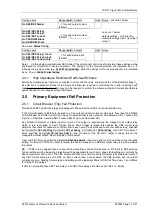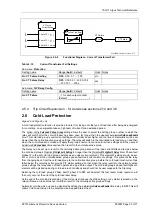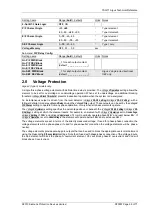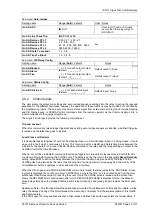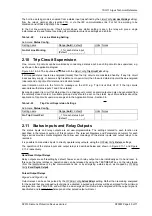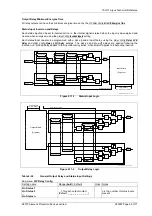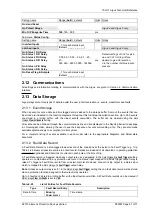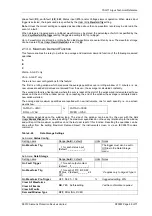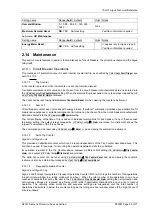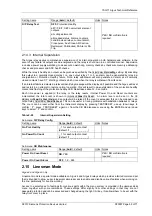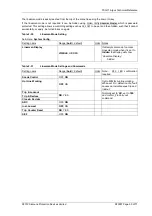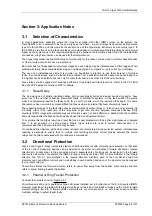
7SG11 Argus Technical Reference
©2013 Siemens Protection Devices Limited
P20007 Page 40 of 71
The relay also provides an Auxiliary Close output that can be mapped to an output relay by
O/P Relay Config.:
AUX
Close
) which will be energised for 200 ms before the end of the close pulse. This output can be used to energise
an external relay with a heavy duty break contact, connected in series with the close coil of the CB, to prevent
output contact damage for a stuck circuit breaker condition. It can replace the anti-pumping timer.
If at the end of the close pulse the circuit breaker has not closed, then the relay will raise a CB FAIL alarm then
Lockout (section 2.5.2). If at the end of the close pulse, the circuit breaker has successfully closed then the relay
will start the Reclaim Delay timer.
Reclaim
After the Circuit Breaker has been successfully reclosed the relay goes into the Reclaim state for the duration of
the Reclaim delay, set by the
Auto-reclose:
Reclaim Time
setting.
If within the Reclaim Delay a new fault occurs and a protection starter picks up, or if an external Arc Start SA input
is raised, then the relay will continue the existing Protection/Auto reclose sequence as programmed.
If within the final Reclaim Delay a new fault occurs and a protection starter picks up, or if an external Arc Start SA
input is raised, then the relay will apply the programmed last shot Protection characteristic, if any protection
element operates a trip output will be issued then the relay will go to Lockout.
If the Reclaim Delay times out without another fault occurring then the relay will Reclaim i.e. reset, the sequence
shot counter will be reset to zero and any subsequent fault will start a full new sequence.
At the start of a Reclaim Delay a ‘Reclaim raised’ event is generated. At the end of a successful Reclaim Delay a
‘Reclaimed cleared’ event is issued and an output is raised, this may be mapped by the user to any output relay
using the
O/P Relay Config.:
Reclaimed
setting.
Lockout
Lockout is a state where the relay truncates the current sequence or operation and resets leaving the Circuit
Breaker Open and no further action is taken. The relay goes to the Lockout state when it reaches the last trip of a
sequence without being able to clear a permanent fault or if conditions are such that a sequence or operation is
truncated without completion. It is not necessary to reset the relay’s Lockout state to be able to close the circuit
breaker.
The number of Reclose attempts in any sequence before the relay locks out can be set by the User by the
Auto-
reclose:
P/F Shots To Lockout:
setting. A sequence of up to four Close shots (five Trips) to Lockout may be set by the
User. When Lockout is reached a Lockout event is issued and an output is raised as defined by the
O/P Relay
Config
.:Lockout Alarm
setting.
The
Auto-reclose:
LO Recovery
delay inhibits all Close & Reclaim commands, from a status input or communications
command, for a set time delay after lockout. The delay can be user selected to
OFF
, or to a set time delay. If set
the delay prevents an operator from repeatedly quickly closing onto a permanent fault, allowing the Plant to cool
between closes preventing overheating / overstressing.
Table 2-19
Auto-reclose from Internal Elements - Settings
Sub-menu:
Auto-reclose
Setting name
Range (
bold
= default)
Units Notes
Gn Line Check Trip
ON
, OFF
Common setting, applies to all
Sequences in that group
Gn Seq Edit/View
‘ALL’ ,
’P/F Sequence’ ,
’E/F Sequence’
,
’SEF/REF Sequence’ ,
’SA Sequence’
The settings below relating to P/F
are repeated for E/F and SEF.
This setting allows the user to
display a subset of them only.
Default depends on relay type.
‘ALL’ shows all settings
Gn P/F [E/F][SEF] ARC
IN
, OUT
Gn P/F [E/F][SEF] Line Check
Trip
INST
, DELAYED
Gn P/F [E/F][SEF] Protection
Trip 1
INST
, DELAYED
Gn P/F [E/F][SEF] Reclose DTL
1
0.20, 0.21…2.0,
2.1…
3.0
…20,21…
300, 360…3600, 3900…14400
sec
Gn P/F [E/F][SEF] Protection
Trip 2
INST
, DELAYED
These settings are for phase-fault
elements; earth-fault (and where
appropriate SEF) protection, have
duplicate sets
e.g. ‘Gn P/F ARC’ becomes ‘Gn
E/F ARC’ or ‘Gn SEF ARC’.






